Business Process Management Article Critique Report: Maturity Models
VerifiedAdded on 2023/01/04
|7
|2132
|69
Report
AI Summary
This report presents a critique of an article titled "Maturity Models in Business Process Management" by Röglinger, Pöppelbuß, and Becker. The article examines various maturity models within BPM, analyzing their strengths, weaknesses, and applicability. The report summarizes the article's key findings, including the identification of ten maturity models and their varying scopes. It highlights the authors' evaluation of these models against design principles and their recommendations for future research, such as the development of more ready-to-use instruments and the consideration of situational maturity models. The critique also discusses the article's limitations, particularly the lack of primary data and the need for a more detailed review of core BPM elements. The report concludes by emphasizing the value of the article's systematic review and its contribution to helping businesses select appropriate maturity models for organizational success.
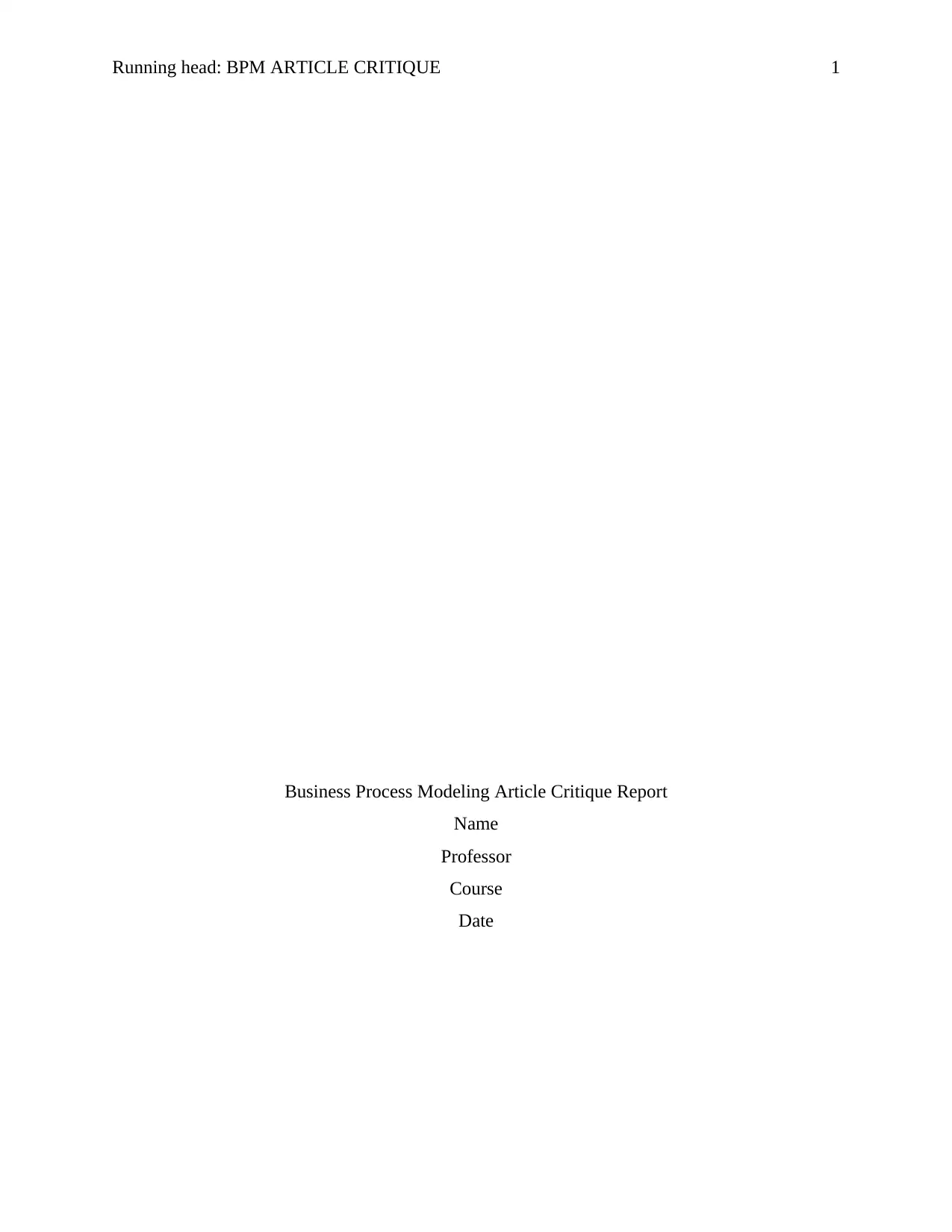
Running head: BPM ARTICLE CRITIQUE 1
Business Process Modeling Article Critique Report
Name
Professor
Course
Date
Business Process Modeling Article Critique Report
Name
Professor
Course
Date
Paraphrase This Document
Need a fresh take? Get an instant paraphrase of this document with our AI Paraphraser
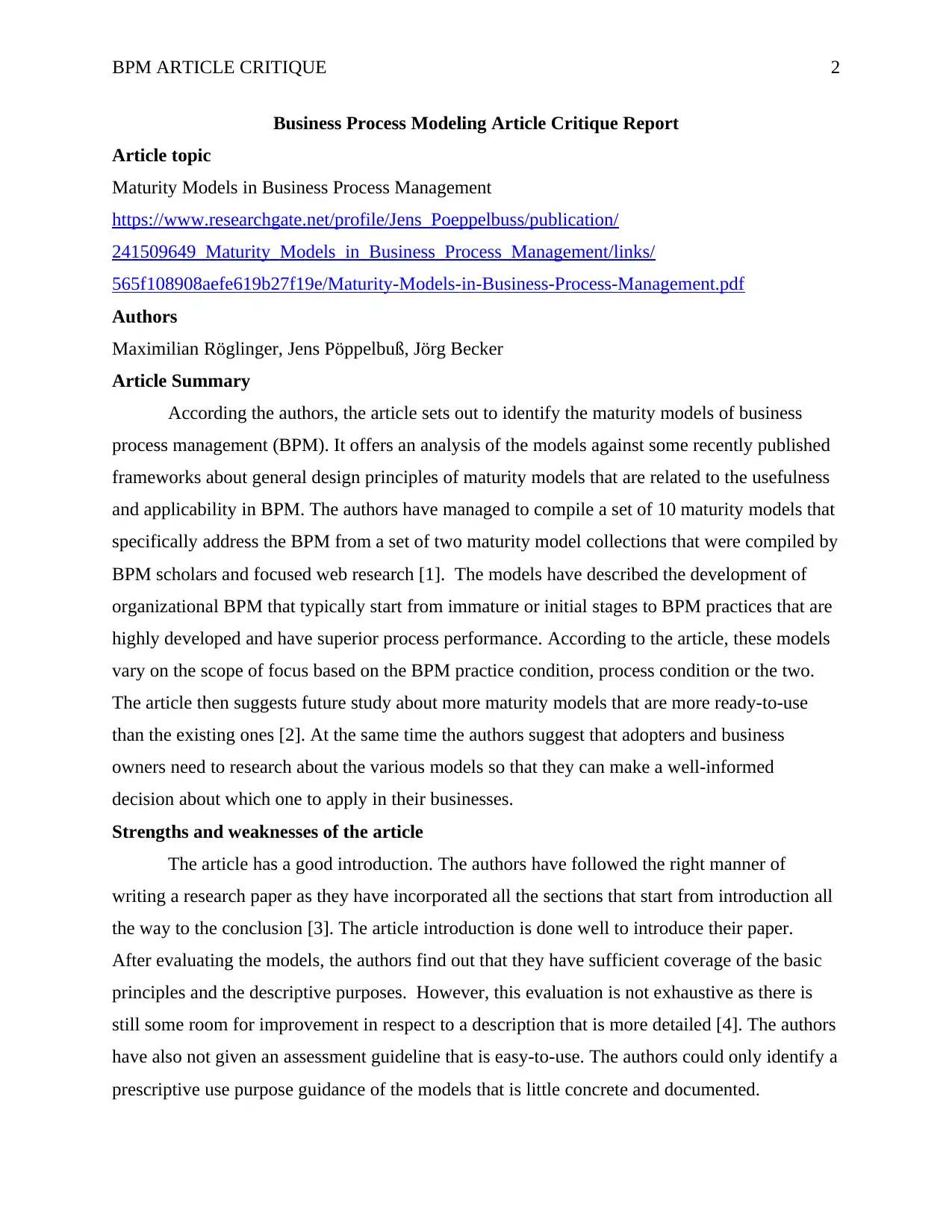
BPM ARTICLE CRITIQUE 2
Business Process Modeling Article Critique Report
Article topic
Maturity Models in Business Process Management
https://www.researchgate.net/profile/Jens_Poeppelbuss/publication/
241509649_Maturity_Models_in_Business_Process_Management/links/
565f108908aefe619b27f19e/Maturity-Models-in-Business-Process-Management.pdf
Authors
Maximilian Röglinger, Jens Pöppelbuß, Jörg Becker
Article Summary
According the authors, the article sets out to identify the maturity models of business
process management (BPM). It offers an analysis of the models against some recently published
frameworks about general design principles of maturity models that are related to the usefulness
and applicability in BPM. The authors have managed to compile a set of 10 maturity models that
specifically address the BPM from a set of two maturity model collections that were compiled by
BPM scholars and focused web research [1]. The models have described the development of
organizational BPM that typically start from immature or initial stages to BPM practices that are
highly developed and have superior process performance. According to the article, these models
vary on the scope of focus based on the BPM practice condition, process condition or the two.
The article then suggests future study about more maturity models that are more ready-to-use
than the existing ones [2]. At the same time the authors suggest that adopters and business
owners need to research about the various models so that they can make a well-informed
decision about which one to apply in their businesses.
Strengths and weaknesses of the article
The article has a good introduction. The authors have followed the right manner of
writing a research paper as they have incorporated all the sections that start from introduction all
the way to the conclusion [3]. The article introduction is done well to introduce their paper.
After evaluating the models, the authors find out that they have sufficient coverage of the basic
principles and the descriptive purposes. However, this evaluation is not exhaustive as there is
still some room for improvement in respect to a description that is more detailed [4]. The authors
have also not given an assessment guideline that is easy-to-use. The authors could only identify a
prescriptive use purpose guidance of the models that is little concrete and documented.
Business Process Modeling Article Critique Report
Article topic
Maturity Models in Business Process Management
https://www.researchgate.net/profile/Jens_Poeppelbuss/publication/
241509649_Maturity_Models_in_Business_Process_Management/links/
565f108908aefe619b27f19e/Maturity-Models-in-Business-Process-Management.pdf
Authors
Maximilian Röglinger, Jens Pöppelbuß, Jörg Becker
Article Summary
According the authors, the article sets out to identify the maturity models of business
process management (BPM). It offers an analysis of the models against some recently published
frameworks about general design principles of maturity models that are related to the usefulness
and applicability in BPM. The authors have managed to compile a set of 10 maturity models that
specifically address the BPM from a set of two maturity model collections that were compiled by
BPM scholars and focused web research [1]. The models have described the development of
organizational BPM that typically start from immature or initial stages to BPM practices that are
highly developed and have superior process performance. According to the article, these models
vary on the scope of focus based on the BPM practice condition, process condition or the two.
The article then suggests future study about more maturity models that are more ready-to-use
than the existing ones [2]. At the same time the authors suggest that adopters and business
owners need to research about the various models so that they can make a well-informed
decision about which one to apply in their businesses.
Strengths and weaknesses of the article
The article has a good introduction. The authors have followed the right manner of
writing a research paper as they have incorporated all the sections that start from introduction all
the way to the conclusion [3]. The article introduction is done well to introduce their paper.
After evaluating the models, the authors find out that they have sufficient coverage of the basic
principles and the descriptive purposes. However, this evaluation is not exhaustive as there is
still some room for improvement in respect to a description that is more detailed [4]. The authors
have also not given an assessment guideline that is easy-to-use. The authors could only identify a
prescriptive use purpose guidance of the models that is little concrete and documented.
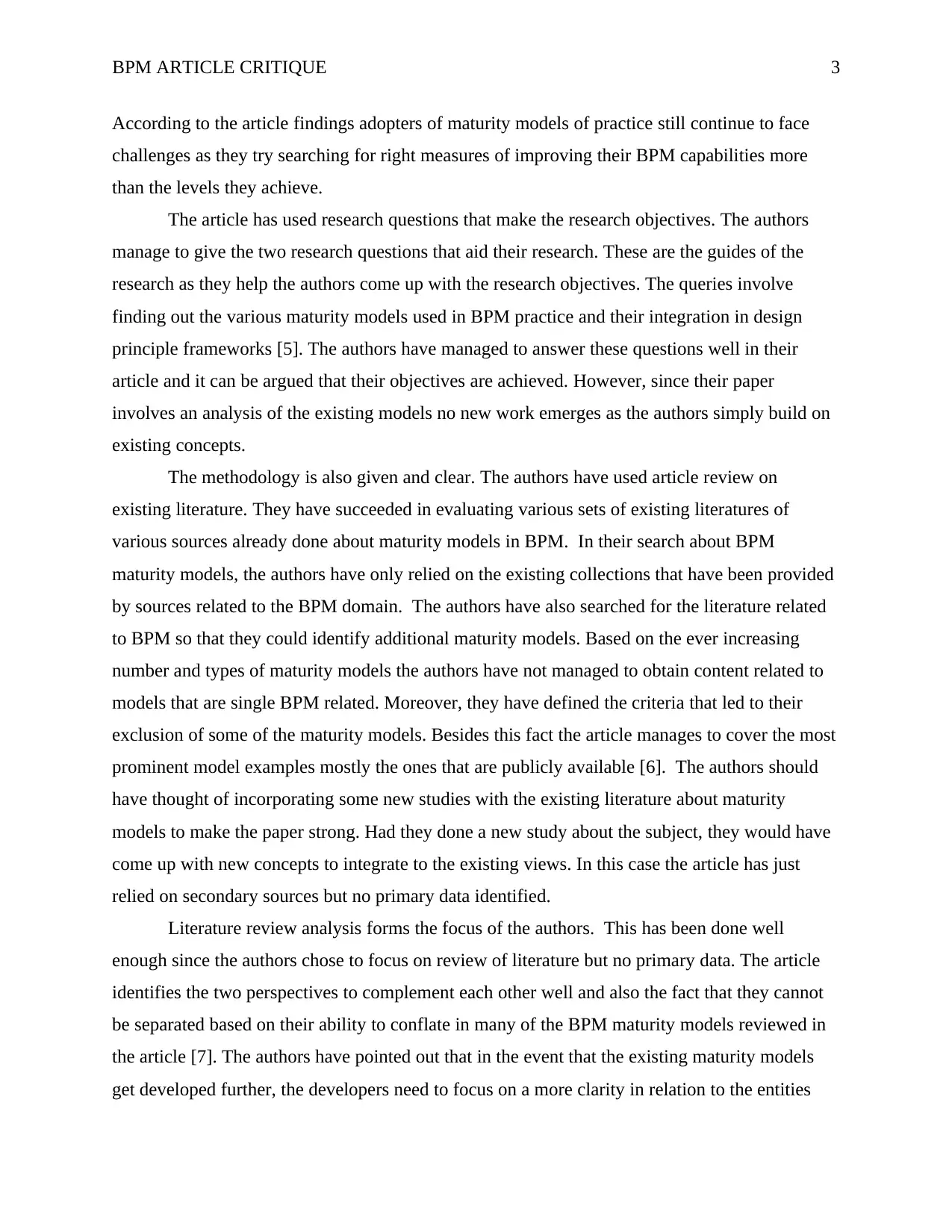
BPM ARTICLE CRITIQUE 3
According to the article findings adopters of maturity models of practice still continue to face
challenges as they try searching for right measures of improving their BPM capabilities more
than the levels they achieve.
The article has used research questions that make the research objectives. The authors
manage to give the two research questions that aid their research. These are the guides of the
research as they help the authors come up with the research objectives. The queries involve
finding out the various maturity models used in BPM practice and their integration in design
principle frameworks [5]. The authors have managed to answer these questions well in their
article and it can be argued that their objectives are achieved. However, since their paper
involves an analysis of the existing models no new work emerges as the authors simply build on
existing concepts.
The methodology is also given and clear. The authors have used article review on
existing literature. They have succeeded in evaluating various sets of existing literatures of
various sources already done about maturity models in BPM. In their search about BPM
maturity models, the authors have only relied on the existing collections that have been provided
by sources related to the BPM domain. The authors have also searched for the literature related
to BPM so that they could identify additional maturity models. Based on the ever increasing
number and types of maturity models the authors have not managed to obtain content related to
models that are single BPM related. Moreover, they have defined the criteria that led to their
exclusion of some of the maturity models. Besides this fact the article manages to cover the most
prominent model examples mostly the ones that are publicly available [6]. The authors should
have thought of incorporating some new studies with the existing literature about maturity
models to make the paper strong. Had they done a new study about the subject, they would have
come up with new concepts to integrate to the existing views. In this case the article has just
relied on secondary sources but no primary data identified.
Literature review analysis forms the focus of the authors. This has been done well
enough since the authors chose to focus on review of literature but no primary data. The article
identifies the two perspectives to complement each other well and also the fact that they cannot
be separated based on their ability to conflate in many of the BPM maturity models reviewed in
the article [7]. The authors have pointed out that in the event that the existing maturity models
get developed further, the developers need to focus on a more clarity in relation to the entities
According to the article findings adopters of maturity models of practice still continue to face
challenges as they try searching for right measures of improving their BPM capabilities more
than the levels they achieve.
The article has used research questions that make the research objectives. The authors
manage to give the two research questions that aid their research. These are the guides of the
research as they help the authors come up with the research objectives. The queries involve
finding out the various maturity models used in BPM practice and their integration in design
principle frameworks [5]. The authors have managed to answer these questions well in their
article and it can be argued that their objectives are achieved. However, since their paper
involves an analysis of the existing models no new work emerges as the authors simply build on
existing concepts.
The methodology is also given and clear. The authors have used article review on
existing literature. They have succeeded in evaluating various sets of existing literatures of
various sources already done about maturity models in BPM. In their search about BPM
maturity models, the authors have only relied on the existing collections that have been provided
by sources related to the BPM domain. The authors have also searched for the literature related
to BPM so that they could identify additional maturity models. Based on the ever increasing
number and types of maturity models the authors have not managed to obtain content related to
models that are single BPM related. Moreover, they have defined the criteria that led to their
exclusion of some of the maturity models. Besides this fact the article manages to cover the most
prominent model examples mostly the ones that are publicly available [6]. The authors should
have thought of incorporating some new studies with the existing literature about maturity
models to make the paper strong. Had they done a new study about the subject, they would have
come up with new concepts to integrate to the existing views. In this case the article has just
relied on secondary sources but no primary data identified.
Literature review analysis forms the focus of the authors. This has been done well
enough since the authors chose to focus on review of literature but no primary data. The article
identifies the two perspectives to complement each other well and also the fact that they cannot
be separated based on their ability to conflate in many of the BPM maturity models reviewed in
the article [7]. The authors have pointed out that in the event that the existing maturity models
get developed further, the developers need to focus on a more clarity in relation to the entities
⊘ This is a preview!⊘
Do you want full access?
Subscribe today to unlock all pages.

Trusted by 1+ million students worldwide
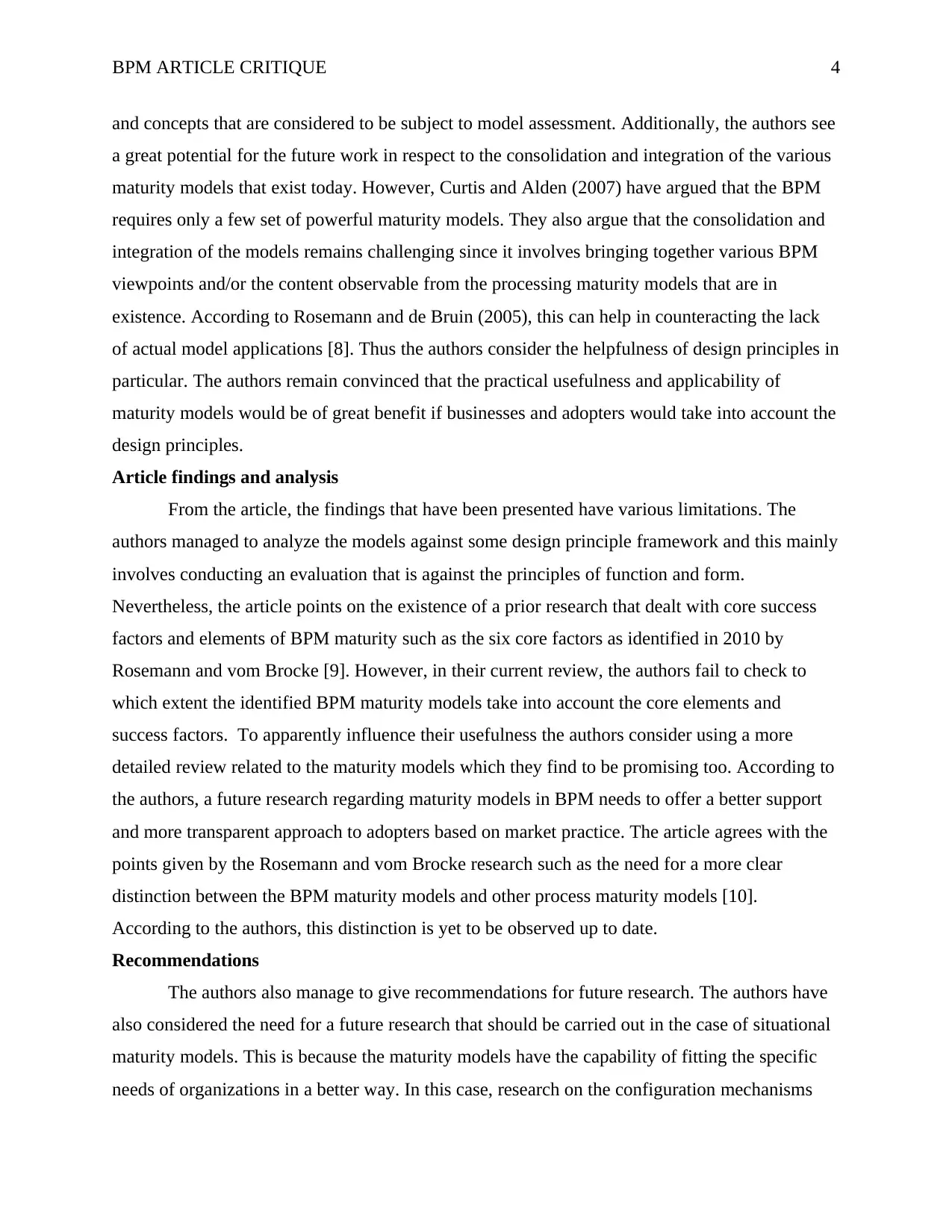
BPM ARTICLE CRITIQUE 4
and concepts that are considered to be subject to model assessment. Additionally, the authors see
a great potential for the future work in respect to the consolidation and integration of the various
maturity models that exist today. However, Curtis and Alden (2007) have argued that the BPM
requires only a few set of powerful maturity models. They also argue that the consolidation and
integration of the models remains challenging since it involves bringing together various BPM
viewpoints and/or the content observable from the processing maturity models that are in
existence. According to Rosemann and de Bruin (2005), this can help in counteracting the lack
of actual model applications [8]. Thus the authors consider the helpfulness of design principles in
particular. The authors remain convinced that the practical usefulness and applicability of
maturity models would be of great benefit if businesses and adopters would take into account the
design principles.
Article findings and analysis
From the article, the findings that have been presented have various limitations. The
authors managed to analyze the models against some design principle framework and this mainly
involves conducting an evaluation that is against the principles of function and form.
Nevertheless, the article points on the existence of a prior research that dealt with core success
factors and elements of BPM maturity such as the six core factors as identified in 2010 by
Rosemann and vom Brocke [9]. However, in their current review, the authors fail to check to
which extent the identified BPM maturity models take into account the core elements and
success factors. To apparently influence their usefulness the authors consider using a more
detailed review related to the maturity models which they find to be promising too. According to
the authors, a future research regarding maturity models in BPM needs to offer a better support
and more transparent approach to adopters based on market practice. The article agrees with the
points given by the Rosemann and vom Brocke research such as the need for a more clear
distinction between the BPM maturity models and other process maturity models [10].
According to the authors, this distinction is yet to be observed up to date.
Recommendations
The authors also manage to give recommendations for future research. The authors have
also considered the need for a future research that should be carried out in the case of situational
maturity models. This is because the maturity models have the capability of fitting the specific
needs of organizations in a better way. In this case, research on the configuration mechanisms
and concepts that are considered to be subject to model assessment. Additionally, the authors see
a great potential for the future work in respect to the consolidation and integration of the various
maturity models that exist today. However, Curtis and Alden (2007) have argued that the BPM
requires only a few set of powerful maturity models. They also argue that the consolidation and
integration of the models remains challenging since it involves bringing together various BPM
viewpoints and/or the content observable from the processing maturity models that are in
existence. According to Rosemann and de Bruin (2005), this can help in counteracting the lack
of actual model applications [8]. Thus the authors consider the helpfulness of design principles in
particular. The authors remain convinced that the practical usefulness and applicability of
maturity models would be of great benefit if businesses and adopters would take into account the
design principles.
Article findings and analysis
From the article, the findings that have been presented have various limitations. The
authors managed to analyze the models against some design principle framework and this mainly
involves conducting an evaluation that is against the principles of function and form.
Nevertheless, the article points on the existence of a prior research that dealt with core success
factors and elements of BPM maturity such as the six core factors as identified in 2010 by
Rosemann and vom Brocke [9]. However, in their current review, the authors fail to check to
which extent the identified BPM maturity models take into account the core elements and
success factors. To apparently influence their usefulness the authors consider using a more
detailed review related to the maturity models which they find to be promising too. According to
the authors, a future research regarding maturity models in BPM needs to offer a better support
and more transparent approach to adopters based on market practice. The article agrees with the
points given by the Rosemann and vom Brocke research such as the need for a more clear
distinction between the BPM maturity models and other process maturity models [10].
According to the authors, this distinction is yet to be observed up to date.
Recommendations
The authors also manage to give recommendations for future research. The authors have
also considered the need for a future research that should be carried out in the case of situational
maturity models. This is because the maturity models have the capability of fitting the specific
needs of organizations in a better way. In this case, research on the configuration mechanisms
Paraphrase This Document
Need a fresh take? Get an instant paraphrase of this document with our AI Paraphraser
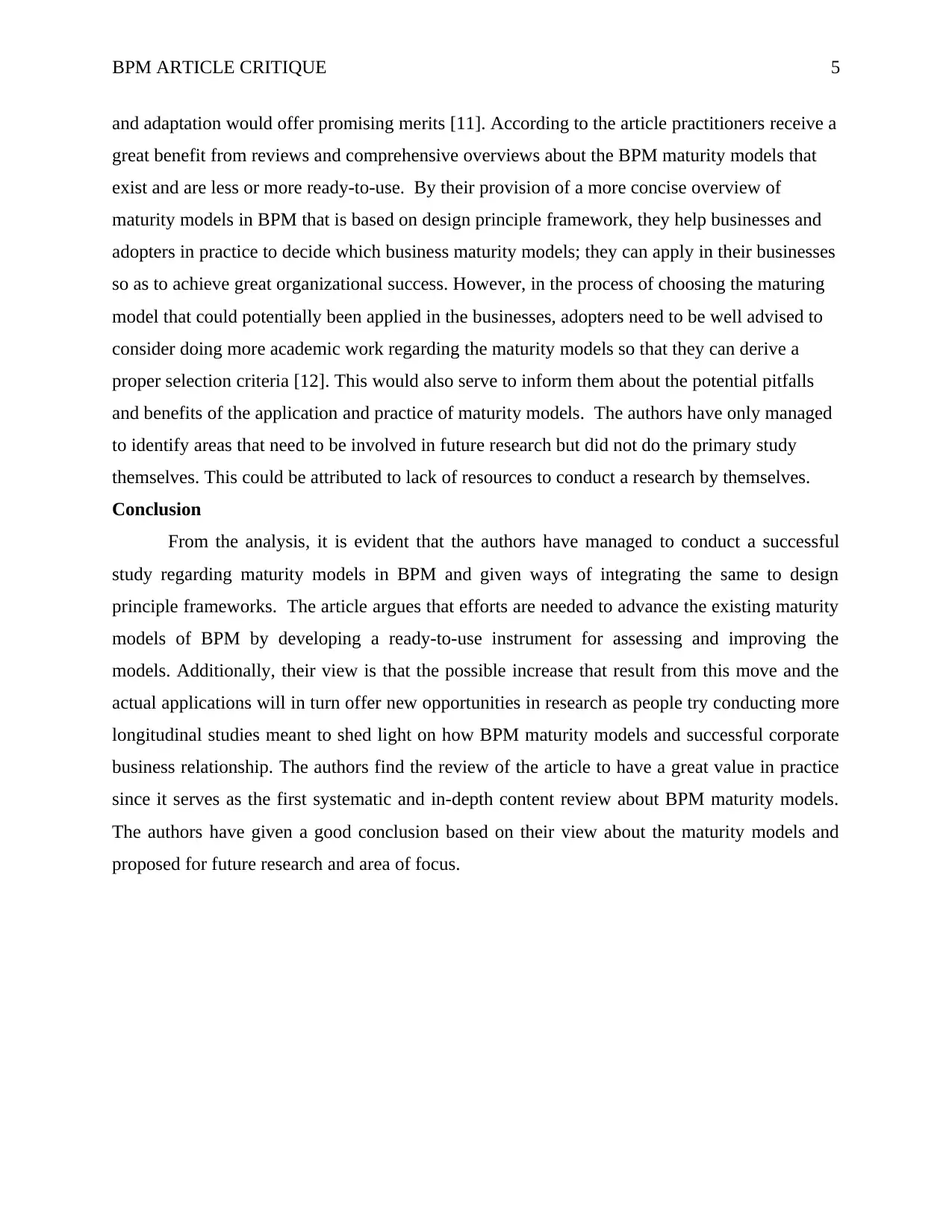
BPM ARTICLE CRITIQUE 5
and adaptation would offer promising merits [11]. According to the article practitioners receive a
great benefit from reviews and comprehensive overviews about the BPM maturity models that
exist and are less or more ready-to-use. By their provision of a more concise overview of
maturity models in BPM that is based on design principle framework, they help businesses and
adopters in practice to decide which business maturity models; they can apply in their businesses
so as to achieve great organizational success. However, in the process of choosing the maturing
model that could potentially been applied in the businesses, adopters need to be well advised to
consider doing more academic work regarding the maturity models so that they can derive a
proper selection criteria [12]. This would also serve to inform them about the potential pitfalls
and benefits of the application and practice of maturity models. The authors have only managed
to identify areas that need to be involved in future research but did not do the primary study
themselves. This could be attributed to lack of resources to conduct a research by themselves.
Conclusion
From the analysis, it is evident that the authors have managed to conduct a successful
study regarding maturity models in BPM and given ways of integrating the same to design
principle frameworks. The article argues that efforts are needed to advance the existing maturity
models of BPM by developing a ready-to-use instrument for assessing and improving the
models. Additionally, their view is that the possible increase that result from this move and the
actual applications will in turn offer new opportunities in research as people try conducting more
longitudinal studies meant to shed light on how BPM maturity models and successful corporate
business relationship. The authors find the review of the article to have a great value in practice
since it serves as the first systematic and in-depth content review about BPM maturity models.
The authors have given a good conclusion based on their view about the maturity models and
proposed for future research and area of focus.
and adaptation would offer promising merits [11]. According to the article practitioners receive a
great benefit from reviews and comprehensive overviews about the BPM maturity models that
exist and are less or more ready-to-use. By their provision of a more concise overview of
maturity models in BPM that is based on design principle framework, they help businesses and
adopters in practice to decide which business maturity models; they can apply in their businesses
so as to achieve great organizational success. However, in the process of choosing the maturing
model that could potentially been applied in the businesses, adopters need to be well advised to
consider doing more academic work regarding the maturity models so that they can derive a
proper selection criteria [12]. This would also serve to inform them about the potential pitfalls
and benefits of the application and practice of maturity models. The authors have only managed
to identify areas that need to be involved in future research but did not do the primary study
themselves. This could be attributed to lack of resources to conduct a research by themselves.
Conclusion
From the analysis, it is evident that the authors have managed to conduct a successful
study regarding maturity models in BPM and given ways of integrating the same to design
principle frameworks. The article argues that efforts are needed to advance the existing maturity
models of BPM by developing a ready-to-use instrument for assessing and improving the
models. Additionally, their view is that the possible increase that result from this move and the
actual applications will in turn offer new opportunities in research as people try conducting more
longitudinal studies meant to shed light on how BPM maturity models and successful corporate
business relationship. The authors find the review of the article to have a great value in practice
since it serves as the first systematic and in-depth content review about BPM maturity models.
The authors have given a good conclusion based on their view about the maturity models and
proposed for future research and area of focus.
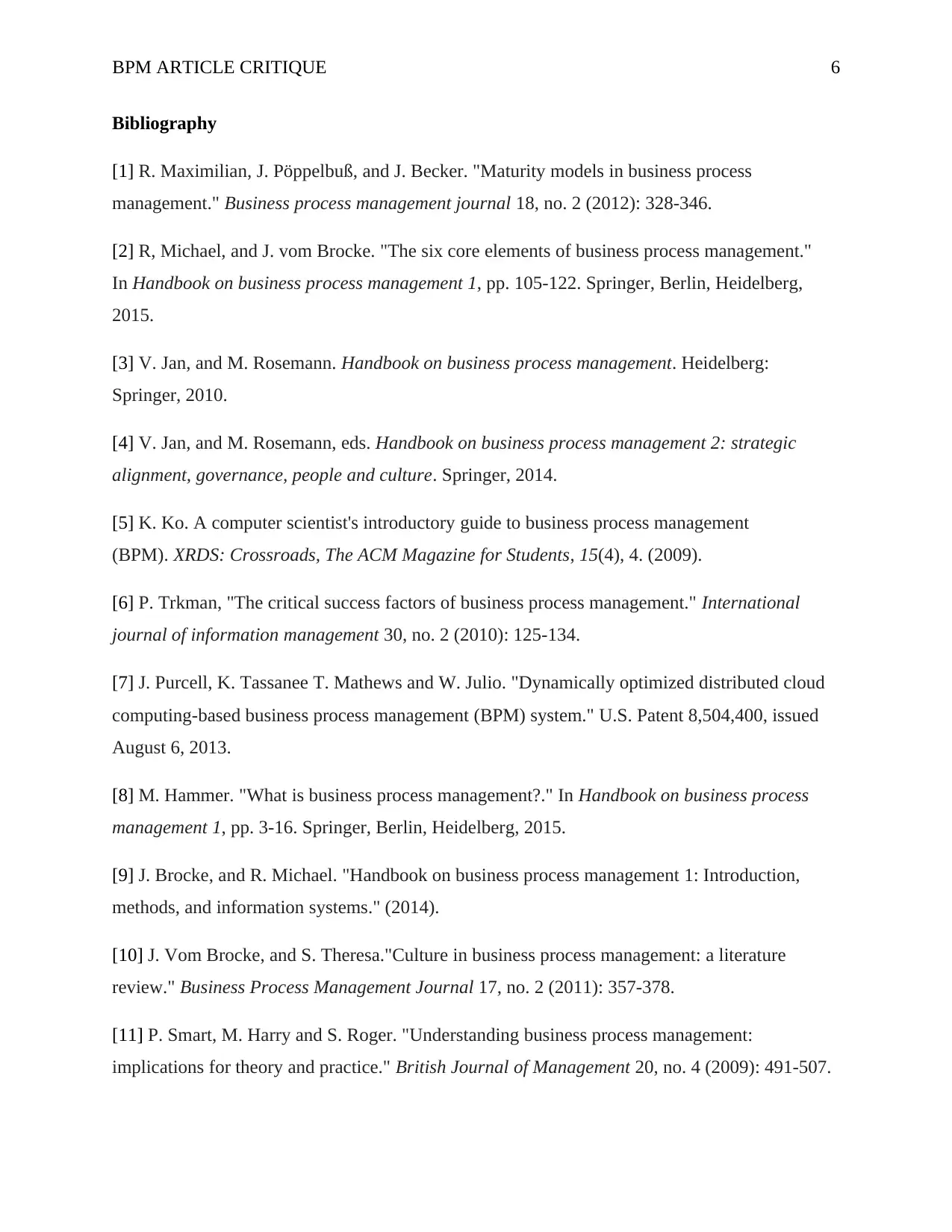
BPM ARTICLE CRITIQUE 6
Bibliography
[1] R. Maximilian, J. Pöppelbuß, and J. Becker. "Maturity models in business process
management." Business process management journal 18, no. 2 (2012): 328-346.
[2] R, Michael, and J. vom Brocke. "The six core elements of business process management."
In Handbook on business process management 1, pp. 105-122. Springer, Berlin, Heidelberg,
2015.
[3] V. Jan, and M. Rosemann. Handbook on business process management. Heidelberg:
Springer, 2010.
[4] V. Jan, and M. Rosemann, eds. Handbook on business process management 2: strategic
alignment, governance, people and culture. Springer, 2014.
[5] K. Ko. A computer scientist's introductory guide to business process management
(BPM). XRDS: Crossroads, The ACM Magazine for Students, 15(4), 4. (2009).
[6] P. Trkman, "The critical success factors of business process management." International
journal of information management 30, no. 2 (2010): 125-134.
[7] J. Purcell, K. Tassanee T. Mathews and W. Julio. "Dynamically optimized distributed cloud
computing-based business process management (BPM) system." U.S. Patent 8,504,400, issued
August 6, 2013.
[8] M. Hammer. "What is business process management?." In Handbook on business process
management 1, pp. 3-16. Springer, Berlin, Heidelberg, 2015.
[9] J. Brocke, and R. Michael. "Handbook on business process management 1: Introduction,
methods, and information systems." (2014).
[10] J. Vom Brocke, and S. Theresa."Culture in business process management: a literature
review." Business Process Management Journal 17, no. 2 (2011): 357-378.
[11] P. Smart, M. Harry and S. Roger. "Understanding business process management:
implications for theory and practice." British Journal of Management 20, no. 4 (2009): 491-507.
Bibliography
[1] R. Maximilian, J. Pöppelbuß, and J. Becker. "Maturity models in business process
management." Business process management journal 18, no. 2 (2012): 328-346.
[2] R, Michael, and J. vom Brocke. "The six core elements of business process management."
In Handbook on business process management 1, pp. 105-122. Springer, Berlin, Heidelberg,
2015.
[3] V. Jan, and M. Rosemann. Handbook on business process management. Heidelberg:
Springer, 2010.
[4] V. Jan, and M. Rosemann, eds. Handbook on business process management 2: strategic
alignment, governance, people and culture. Springer, 2014.
[5] K. Ko. A computer scientist's introductory guide to business process management
(BPM). XRDS: Crossroads, The ACM Magazine for Students, 15(4), 4. (2009).
[6] P. Trkman, "The critical success factors of business process management." International
journal of information management 30, no. 2 (2010): 125-134.
[7] J. Purcell, K. Tassanee T. Mathews and W. Julio. "Dynamically optimized distributed cloud
computing-based business process management (BPM) system." U.S. Patent 8,504,400, issued
August 6, 2013.
[8] M. Hammer. "What is business process management?." In Handbook on business process
management 1, pp. 3-16. Springer, Berlin, Heidelberg, 2015.
[9] J. Brocke, and R. Michael. "Handbook on business process management 1: Introduction,
methods, and information systems." (2014).
[10] J. Vom Brocke, and S. Theresa."Culture in business process management: a literature
review." Business Process Management Journal 17, no. 2 (2011): 357-378.
[11] P. Smart, M. Harry and S. Roger. "Understanding business process management:
implications for theory and practice." British Journal of Management 20, no. 4 (2009): 491-507.
⊘ This is a preview!⊘
Do you want full access?
Subscribe today to unlock all pages.

Trusted by 1+ million students worldwide

BPM ARTICLE CRITIQUE 7
[12] F. Chang. Business process management systems: strategy and implementation. Auerbach
Publications, 2016.
[12] F. Chang. Business process management systems: strategy and implementation. Auerbach
Publications, 2016.
1 out of 7
Related Documents
Your All-in-One AI-Powered Toolkit for Academic Success.
+13062052269
info@desklib.com
Available 24*7 on WhatsApp / Email
![[object Object]](/_next/static/media/star-bottom.7253800d.svg)
Unlock your academic potential
Copyright © 2020–2025 A2Z Services. All Rights Reserved. Developed and managed by ZUCOL.



